Understanding Anxiety

Anxiety is a common experience that occurs when we feel fearful, worried, or tense. While anxiety often carries a negative connotation due to its impact on our relationships, work, and overall health, it's crucial to recognise that not all anxiety is harmful. In fact, anxiety serves an essential function, enabling us to respond effectively to certain situations. However, it becomes problematic when it begins to dominate our lives, leading to persistent worry and significantly affecting our ability to function day to day.
The Nature of Anxiety and Its Effects
Anxiety is often likened to fear, as both emotions heighten our awareness and prepare us for action. However, a key distinction is that anxiety frequently occurs without the presence of an immediate threat, making it a more pervasive and insidious condition. This is why anxiety can feel overwhelming, as it often lingers even when there is no clear danger.
The Fight or Flight Response: Our Body’s Alarm System
When we perceive danger—whether real or imagined—our bodies activate a set of physiological changes known as the "fight or flight" response. This is an ancient survival mechanism that prepares us to either confront or escape from a threat. The response is automatic and involves multiple systems within our body: physical, cognitive, and behavioural.
- Physical Response: When a threat is perceived, the brain signals the autonomic nervous system, particularly the sympathetic branch, to take action. This triggers the release of stress hormones such as adrenaline and cortisol, leading to increased heart rate, enhanced blood flow to muscles, and faster breathing. These changes equip us for quick action but can leave us feeling fatigued once the threat has passed.
- Cognitive Response: The physical symptoms of anxiety are very real, and our minds often interpret these sensations as evidence of danger. This can create a feedback loop where the anxiety escalates, potentially leading to panic. The brain's tendency to over-interpret these signals can make the situation worse, reinforcing the anxiety.
- Behavioural Response: The instinctual behaviours associated with the fight or flight response include an urge to escape or, conversely, to confront the perceived threat. Unfortunately, these responses can sometimes perpetuate the anxiety, making it more challenging to break the cycle.
Returning to Calm: The Role of the Parasympathetic Nervous System
Once the perceived threat has subsided, the body engages the parasympathetic nervous system to restore a state of calm. This system works to slow the heart rate, reduce breathing intensity, relax the muscles, and lower overall body temperature. However, it’s important to understand that the transition from a state of heightened alertness to relaxation is not instantaneous. The aftereffects of anxiety can linger, and it may take some time for the body to fully recover.
Recognising the Symptoms of Anxiety and Related Disorders
Anxiety can present itself in various forms, affecting both the mind and body. Common symptoms include prolonged worry, physical tension, headaches, digestive issues, and sleep disturbances. Emotionally, anxiety can manifest as irritability, a pervasive sense of dread, or social withdrawal.
To know more about anxiety and its treatment or to book an appointment with our Clinical Psychologist, please contact us at Energizing Minds psychology.
